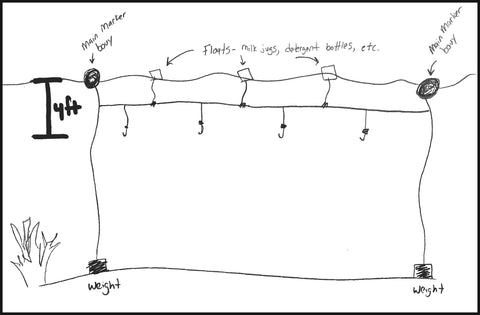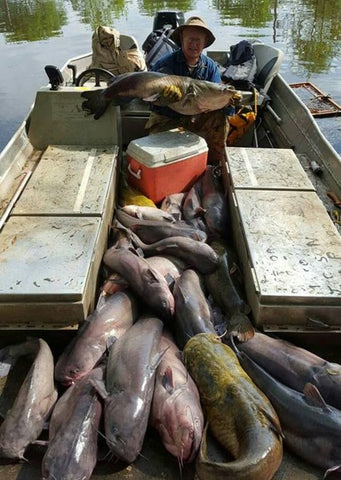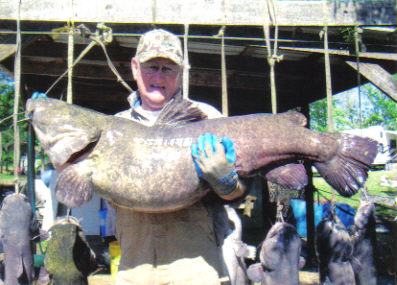
Best Bait For Catfish – Using Common Sense in 2024!
Share
So, what is the "Best Bait" for Catfish? I will tell you… I have been building bait fish traps here in Texas for since about 2007, and we send these traps all over the United States and even into Canada, Puerto Rico, and Australia! If a trap exists… I have seen it and have most likely built it. Outside of building traps, I have been fishing my entire life. Some of my earliest memories involve running trotlines on Sam Rayburn with my stepdad, and constantly fighting with our old Evinrude outboard (that’s another story though). I can safely say that I have been around catfish my entire life, and there are plenty of pics here on our site and on our Facebook page that will give me just a little “street-credit.”

Over the past ten years, and well… forever really, a common question or theme going around the catfish scene is what is the “best catfish bait” out there? If you fish for catfish, then I’m sure you’ve wondered the same… and possibly even Googled it. As a matter of fact, a recent Google search came up with 11.9 million (YES, MILLION) results for the “best catfish bait.” See image below…. this is from 2024!

Take just a second to think about these search results? There are 11.9 million sites out there that have an opinion on what the best bait for catching catfish would be, and they all want your attention.
Not all, but many of these sites are quick sales pitches that claim that you will certainly catch the most catfish if you would just buy their punch baits, fiber baits, dip baits, scented chicken livers, or colored hot-dog weeny things. Catfishing is a big market, and lots of companies spend a lot of money to get their mediocre baits in front of fishermen. Almost all of these manufactured baits extist simply because they're marketed and it's easy for fishermen to purchase and have bait. Basically, manufactured bait is a convenience because it's easy to come by.
However, are these products really the best bait to catch catfish?
The Common Sense Approach… Best Bait For Catfish
Let’s think about this logically. What did catfish do before man started manufacturing stink baits? How did they survive and what did they eat before the gambit of options appeared on the market?
Despite the old saying that catfish are “scavengers”, catfish are absolutely a predator species of fish. If you've ever caught one on a rattle trap or spinner bait while bass fishing, then you know this to be true.
As a matter of fact, the trotline setup we use to target catfish is designed specifically to appeal to their predator nature. Check out the trotline diagram image below. We actually float our lines up off the botom of the lake and our bait sits suspended in the water column where wind and wave action move the bait. It does not sit on the bottom waiting to be scavenged.

In summary, catfish are not this bottom-dwelling scagenger fish getting the leftovers from above and cleaning out our lakes and pods. Do they do some of this? Sure! However, common sense should tell us that they've survied by eating what was around them and available to them since their creation by God.

Dispelling the Myth: No Magic Bullet for the Best Catfish Bait
If you take away anything from this blog post, understand this… there’s no “best” bait for catfish, and there's no magic bullet that will catch you more fish. It doesn’t exist…save your money. This means that if you truly want to catch more catfish, then you need to be using what is natural in their environment. For example, if you live in a lake with lots of Shad and Sunfish, then you will always catch more fish using sunfish and shad than you will any other manufactured bait.
When Manufactured Baits Really are the Best Catfish Bait
I understand that this blog post comes across as me bashing all manufactured baits. Please know that is not the intent. The intent here is to step back and encourage folks to use common sense if they're wanting to catch more and bigger catfish.
Now, can you catch fish on the manufactured stuff? Of course… I mean the industry is huge for a reason, right? Manufactured baits like Danny King's Catfish Punch Bait, Catfish Charlie' Blood Dip Bait, and many other dough baits are all great and will catch you some fish. However, word to the wise... all of these baits are based on the premise of smell. They all stink pretty badly and will definitely leave your hands smelling foul if used without gloves. In regard to birth control, these baits would definitely do the trick as your signifcant other won't want any part of you until this smell gone. = )
So when would I recommend using manufactured stink baits?
I would recommend these manufactured baits as a matter of convenience. The following are examples of when I would recommend using these types of baits.
- Time Cruch - You went on a last minute fishing trip, or you're in a pinch for time and do not have the time to catch your own bait.
- No Trap - You don't own a bait fish trap or cast net to catch your own bait.
That's about it, honestly. To me, manufactured baits are simply a matter of convenience. They're cheap and easy, but don't offer to be the best bait for catfish on most occassions.
Recap: Natural Bait is the Best Bait for Catfish
In contrast to manufactured baits, if you want to absolutely tear the fish up… I mean fill your boat up with 500+ lbs (check out the image below) off a trotline, then you are going to have to use what naturally occurs in that environment.

Guide: Ed Snelson of Huntington, Texas
For this reason, pretty much the only baits we use while running trotlines here in Texas are perch (sunfish) and shad. Sure, we will occasionally throw some weenies or cut up cow tongue on a hook if we don’t have time to properly set our traps, but our “go-to” bait is always some type of bait fish.

Family Time - Running Trotlines

Ed Snelson, Fishing Guide
Invest in Wise Fishing Products - The Best Catfish Bait Solution
If your goal is to maximize the time you get to spend on the water by catching more and larger catfish, then you're going to need to make an investment in either time building your own bait fish traps or money to purchase a good quality trap. Either way, it will be an investment on your part if you want the best possible bait for the catfish in your body of water.
Sure, traps and nets are more expensive that punch baits… but traps and nets will pay for themselves over and over before that punch bait does. This is absolutely one of those "you pay for what you get" type of deals. For example, check out this video of what a good bait fish trap can do for an angler. Imagine if you had 5 of these z-traps out. You'd never run of bait again.
Conclusion: The Best Bait for Catfish
My advice, if you want to use the best best bait for catfish available to you, then invest in a good trap or cast net before your next outing, and then be prepared to spend some time using it. Budget this time into your trip!
Am I saying you have to buy a Reel Texas Outdoors bait fish trap to be successul? Absolutely not. You may find a good bait fish trap locally at a feed or hardware store, or you may be handy enough to build one your own. Either way, trapping and netting your bait fish is definitely the way to go if you're wanting the best catfish bait available to you.
Now, if you are wanting a solid bait fish trap and are not sure where to start, then I'd love for you to consider purchasing a handmade trap from us. We make excellent quality bait fish traps that simply CATCH THE BAIT. If you want more info on our traps, I would recommend starting by checking out the tried and true, Four Leaf Clover Perch Trap linked here.
I hope this blog info was helpful to you in some way. Iff you enjoyed it, then please don’t hesitate to share it. It helps our small company out too. = )
God bless, and tight lines!
Mike

2 comments
The best bait is dump a box of worms into a panty hose foot and tie it off so they don’t get eaten out of it . It works for armidillos in live traps too . Just wet them down good and don’t put in trap till dark .
I am so glad I discovered you and your Company Mike. You guys sound like true American Sportsman and I look forward to doing business with you!